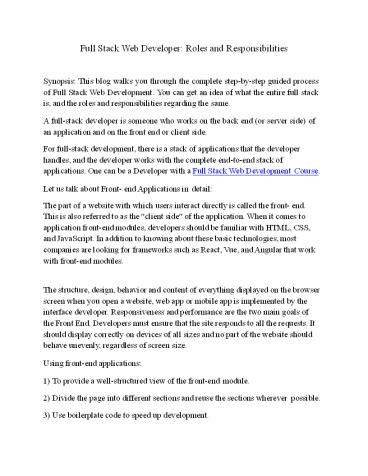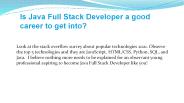Full Stack Developer : Roles and Responsibilities - PowerPoint PPT Presentation
Title:
Full Stack Developer : Roles and Responsibilities
Description:
A full-stack developer is someone who works on the back end (or server side) of an application and on the front end or client side. – PowerPoint PPT presentation
Number of Views:54
Title: Full Stack Developer : Roles and Responsibilities
1
- Full Stack Web Developer Roles and
Responsibilities - Synopsis This blog walks you through the
complete step-by-step guided process of Full
Stack Web Development. You can get an idea of
what the entire full stack is, and the roles and
responsibilities regarding the same. - A full-stack developer is someone who works on
the back end (or server side) of an application
and on the front end or client side. - For full-stack development, there is a stack of
applications that the developer handles, and the
developer works with the complete end-to-end
stack of applications. One can be a Developer
with a Full Stack Web Development Course. - Let us talk about Front- end Applications in
detail - The part of a website with which users interact
directly is called the front- end. This is also
referred to as the "client side" of the
application. When it comes to application
front-end modules, developers should be familiar
with HTML, CSS, and JavaScript. In addition to
knowing about these basic technologies, most
companies are looking for frameworks such as
React, Vue, and Angular that work with front-end
modules. - The structure, design, behavior and content of
everything displayed on the browser screen when
you open a website, web app or mobile app is
implemented by the interface developer.
Responsiveness and performance are the two main
goals of the Front End. Developers must ensure
that the site responds to all the requests. It
should display correctly on devices of all sizes
and no part of the website should behave
unevenly, regardless of screen size. - Using front-end applications
- To provide a well-structured view of the
front-end module. - Divide the page into different sections and reuse
the sections wherever possible. - Use boilerplate code to speed up development.
2
- To have a standard look and feel for the user
interface. - Keep your code efficient. Back- end
Applications - The back- end is the server side of your website.
It saves and organizes your data to make sure
everything is working properly on the client side
of your website. - Backend application modules are usually written
in Java. Creating a backend module requires
knowledge of core Java, Jakarta Enterprise
Edition, formerly j2ee. This includes Servlets,
REST, JSON APIs, async, and events from the
server. Parts and characteristics developed by
the backend designer are indirectly accessed by
the user through the frontend application. - Using the back- end application
- Faster development process and shorter marketing
time. - Build perfect and great applications.
- Cloning the application and running the test
environment. - Maintain security.
- Role and Responsibilities as a Full- Stack
Developer - Full-stack developers need to work on developing
large-scale applications as the sole employee,
without relying on the other programmers in the
team. Building large-scale applications requires
prior knowledge to develop the application from
scratch. - While full-stack developers have their own
requirements for every organization, here are
some of the most important tasks a developer
needs to perform - Create an interactive user interface using a
variety of front-end technologies. - You need to be able to design a robust back- end
architecture using a variety of technologies for
recover data from the server. - Design strategies for continuous improvement,
performance optimization, stability and
scalability
3
- Can design user experience, user interactive,
responsive, and complete architecture. - Works with third-party databases, servers, APIs,
version control systems, and apps. - Provides insight into continuous improvement and
add / remove features as needed. - Handle the development team and communicate well
with them to improve the product road- map /
performance. - Lead a team of developers, designers, and network
managers to ensure that your digital results are
in line with your business goals. - Thorough documentation of application and end
product deployment using appropriate cloud
services or similar methods. - Transform business requirements into finished
products from conception to implementation. - Given are the specific roles and responsibilities
for full-time developers. From these mentioned
above it is clear that there are many positions
to explore in a professional career. Different
skills will help you find different positions
with the best pay structures. - Conclusion
- A Full Stack developer career is full of
challenges and cannot be achieved overnight.
Mastering the various skills requires a lot of
effort and patience! - Source https//www.clariwell.in/blogs































